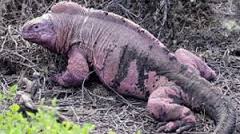Galápagos pink land iguana facts for kids
Quick facts for kids Galápagos pink land iguana |
|
|---|---|
 |
|
| Conservation status | |
| Scientific classification | |
| Genus: |
Conolophus
|
| Species: |
marthae
|
The Conolophus marthae, also known as the Galápagos pink land iguana, is a special kind of lizard. It belongs to the Iguanidae family. This amazing iguana is found only in one place: the Wolf Volcano in the northern part of Isabela Island. This island is part of the famous Galápagos Islands in Ecuador.
What makes this iguana so unique? Its body is pink with some dark stripes! Because of its color, some people call it the pink iguana or the Galápagos rosy iguana. Scientists first spotted this species in 1986. They later confirmed in 2009 that it was a completely different species from the well-known Galápagos land iguana. This pink iguana is a very important example of how species have changed over millions of years within the Conolophus group. It is also a critically endangered animal, meaning it is at very high risk of disappearing forever.
Contents
Naming the Pink Iguana
The scientific name for the pink iguana is Conolophus marthae. When scientists first thought about naming it, they considered rosada. This Spanish word means "pinkish," which perfectly describes the iguana's color.
However, they later chose the name marthae. This name honors Martha Rebecca Gentile, the daughter of Gabriele Gentile. He was one of the scientists who officially described this new species.
Scientists officially announced this iguana as a new species in 2009. Early studies of its DNA suggested it separated from its relatives about 5.7 million years ago. These relatives include the yellow Galápagos land iguana and the Santa Fe land iguana. More recent studies suggest this split happened about 1.5 million years ago.
What Does the Pink Iguana Look Like?
The Conolophus marthae looks a lot like its close relative, the Galápagos land iguana. Both are typical lizards. They have strong, four-legged bodies with long tails. Their legs spread out to the sides, just like most lizards. A line of short spines runs down the middle of their backs, from their neck to their tail.
But there are some key differences. The pink iguana's crest, which is the row of spines on its back, is a bit different. The biggest difference, of course, is its color! The C. marthae is pink with wide, dark stripes going down its body. This is very different from the yellow-brown color of the other Galápagos land iguanas. Also, the pink iguana has a more complex way of nodding its head. This head-nodding is how iguanas show who is in charge of their territory.
The first pink iguana that scientists measured was an adult male. It weighed about 5 kg (11 lb). Its body, from snout to vent (where the tail starts), was about 47 cm (19 in) long. Its tail was even longer, at about 61.4 cm (24.2 in). After scientists took these measurements and samples, they released the iguana back into the wild.
Where Do Pink Iguanas Live?
People first learned about these pink lizards in 1986. That's when park rangers saw them on the Wolf Volcano on Isabela Island. However, scientists didn't start studying them closely until the year 2000.
The Wolf Volcano is the only place in the world where these iguanas live. Their home covers a small area of only about 25 km2 (10 sq mi). They live at high altitudes, between 600 and 1,700 m (2,000–5,600 ft) up the volcano.
Protecting the Pink Iguana
There are fewer than 200 adult pink iguanas left in the wild. When scientists first described them, they suggested the species should be called critically endangered species. This is because they live in such a tiny area and have so few individuals. The IUCN (International Union for Conservation of Nature) agreed in 2012.
The area where they live is not inhabited by humans. It's also very hard to reach, which makes it difficult for scientists to study them. The Galápagos pink land iguana faces threats from animals that humans have brought to the islands. These include feral cats and black rats. These animals can eat the iguanas' eggs and young babies. The only natural animal that hunts the pink iguana is the Galápagos hawk.
Other dangers include the possibility of hybridization. This means the pink iguanas could mate with the yellow Galápagos land iguanas. Their living areas touch, and genetic evidence shows this has happened in the past. Another big threat is the Wolf Volcano itself. It can erupt, and it did so as recently as 2022. A large eruption could harm or wipe out the entire population.
To help save the pink iguana, scientists have suggested starting a captive breeding program. This is where animals are bred in a safe environment, like a zoo, to increase their numbers. A similar program has already been very successful for some populations of the yellow Galápagos land iguana.
See also
 In Spanish: Iguana terrestre rosada para niños
In Spanish: Iguana terrestre rosada para niños


